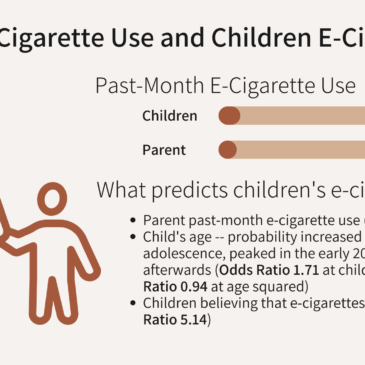Editor’s Note: Today’s review is part of our month-long Special Series on Pathways to Addiction. Throughout March, The BASIS is highlighting risk factors for and pathways to addiction.
E-cigarettes, also known as “vapes” and “mods,” entered the U.S. market in 2007 and became the tobacco product most used by youth in 2014. By 2020, about 1 in 5 high schoolers and 1 in 20 middle schoolers reported using e-cigarettes in the past month. Studies have shown that kids who do so are more likely to smoke combustible cigarettes in the future. About a quarter of U.S. adults of parenting age also have used an e-cigarette. This week, as part of our Special Series on Pathways to Addiction, ASHES reviews a study by Jennifer Bailey and colleagues that examines the relationship between parental e-cigarette use and their kids’ use.
What was the research question?
Does parental e-cigarette use predict their children’s e-cigarette use?
What did the researchers do?
The researchers used data from the Seattle Social Development Project – The Intergenerational Project. They looked at waves 8-10 of this study, ranging from 2015-2017. They examined 295 families (parents and children) to assess e-cigarette use, conventional cigarette use, and nicotine use in the past month, as well as participants’ perceptions of the safety of e-cigarette use at each wave. They used fixed-effects regression models to analyze relationships between these variables.
What did they find?
About 12% of youth participants and 8% of parents self-reported using e-cigarettes in the past month at any point during the years the survey was conducted (see Figure). Children of parents who used e-cigarettes had significantly greater odds of reporting using e-cigarettes themselves, even after accounting for parental cigarette use. Children’s perceptions of e-cigarette safety also predicted greater odds of past-month e-cigarette use. However, parents’ perceptions of e-cigarette safety did not predict their children’s past-month e-cigarette use. The relationship between children’s age and e-cigarette use was curvilinear, meaning that increased age was initially associated with increased use, but eventually decreased use as youth got older.

Figure. Prevalence of past-month e-cigarette use among parents and children within families (N = 295) and statistically significant odds ratios predicting children’s cigarette use. Click image to enlarge.
Why do these findings matter?
This study suggests that it is important for policymakers and researchers to build prevention programs and campaigns with an additional focus on preventing e-cigarette use among the children of parents who use e-cigarettes. For example, a public health awareness campaign aimed at parents who use e-cigarettes or combustible tobacco products might emphasize the dangers of passing these behaviors on to kids.
Every study has limitations. What are the limitations of this study?
This study did not have enough parent participants who only used e-cigarettes, thus limiting its ability to determine if parental e-cigarette use alone predicts children’s e-cigarette use, rather than just general nicotine product use. Additionally, while they assessed the prevalence of e-cigarette use (whether someone ever used, or not), the frequency of use was not measured, which could be an important omission.
For more information:
SmokeFree offers tools and tips for quitting and maintaining abstinence from smoking tobacco. The Talk With Your Teen About E-cigarettes tip sheet provides tips for parents to explain why e-cigarettes are harmful. The Centers for Disease Control and Prevention also provides research and tips about cigarettes and how to quit. For more details about addiction, visit our Addiction Resources page.
— Taylor Lee
What do you think? Please use the comment link below to provide feedback on this article.




